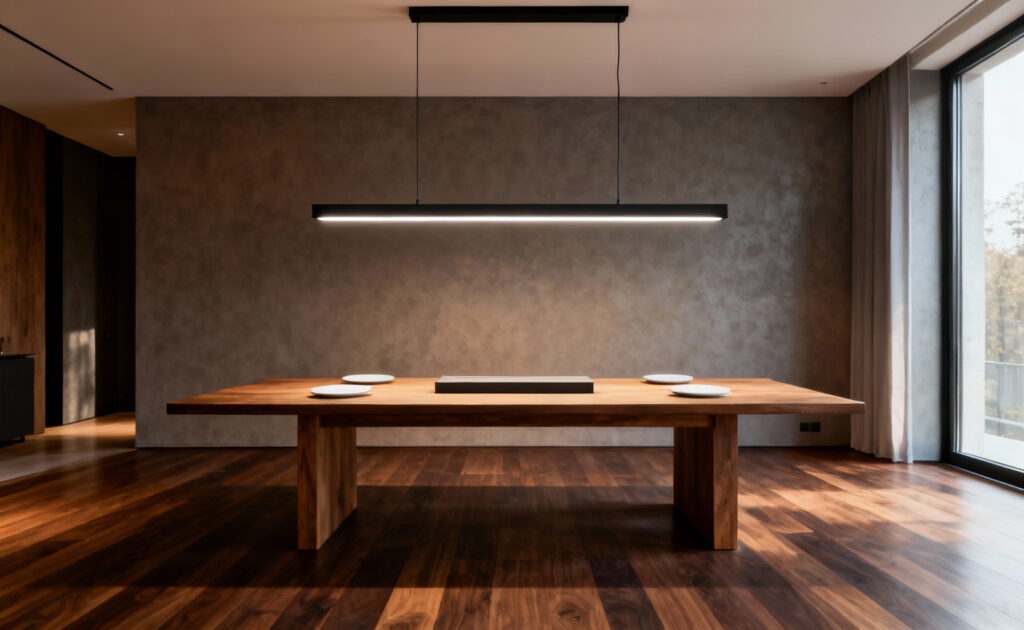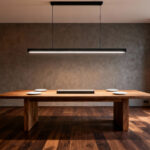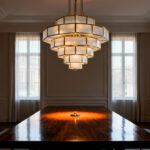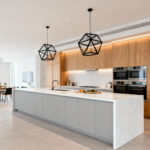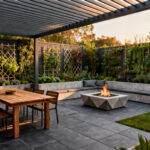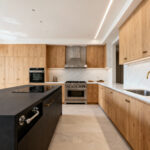Most hosts believe the menu defines a successful dinner party. Consequently, they pour energy into culinary perfection. However, an unseen guest actually controls the evening’s atmosphere: the quality and design of your dining room light fixtures. Historically, chandeliers declared status through intense brightness. Today, though, true luxury implies intimacy. Indeed, a quiet, unhurried space values mood over mere visibility.
Lighting acts as a subconscious director of behavior. It subtly guides mood and even biological functions. Specifically, warm golden light amplifies the sensory experience. Under this glow, food appears richer and more appetizing. Conversely, harsh light often inhibits relaxation. Science confirms that soft illumination encourages guests to linger. Therefore, the right fixture fosters a sense of privacy and emotional safety.
Achieving this balance requires a theatrical design approach. Thus, sophisticated spaces rely on layering light sources. You must balance ambient glow with focused task lighting. Furthermore, high color rendering validates your culinary efforts. This guide explores the strategic use of illumination. We reveal how to transform a meal into an experience. Ultimately, you will learn to set the perfect scene.
1. The Linear Suspension: Anchoring the Long Rectangular Feast
Ideally, lighting should mirror your furniture’s geometry. Specifically, the linear suspension fixture is the quintessential choice for rectangular dining tables. Historically, this design shares DNA with the classic billiard table light. Indeed, its original purpose was providing uniform, shadow-free illumination. Consequently, this functional legacy translates perfectly to the modern dining feast. It ensures every plate receives balanced light without glare.
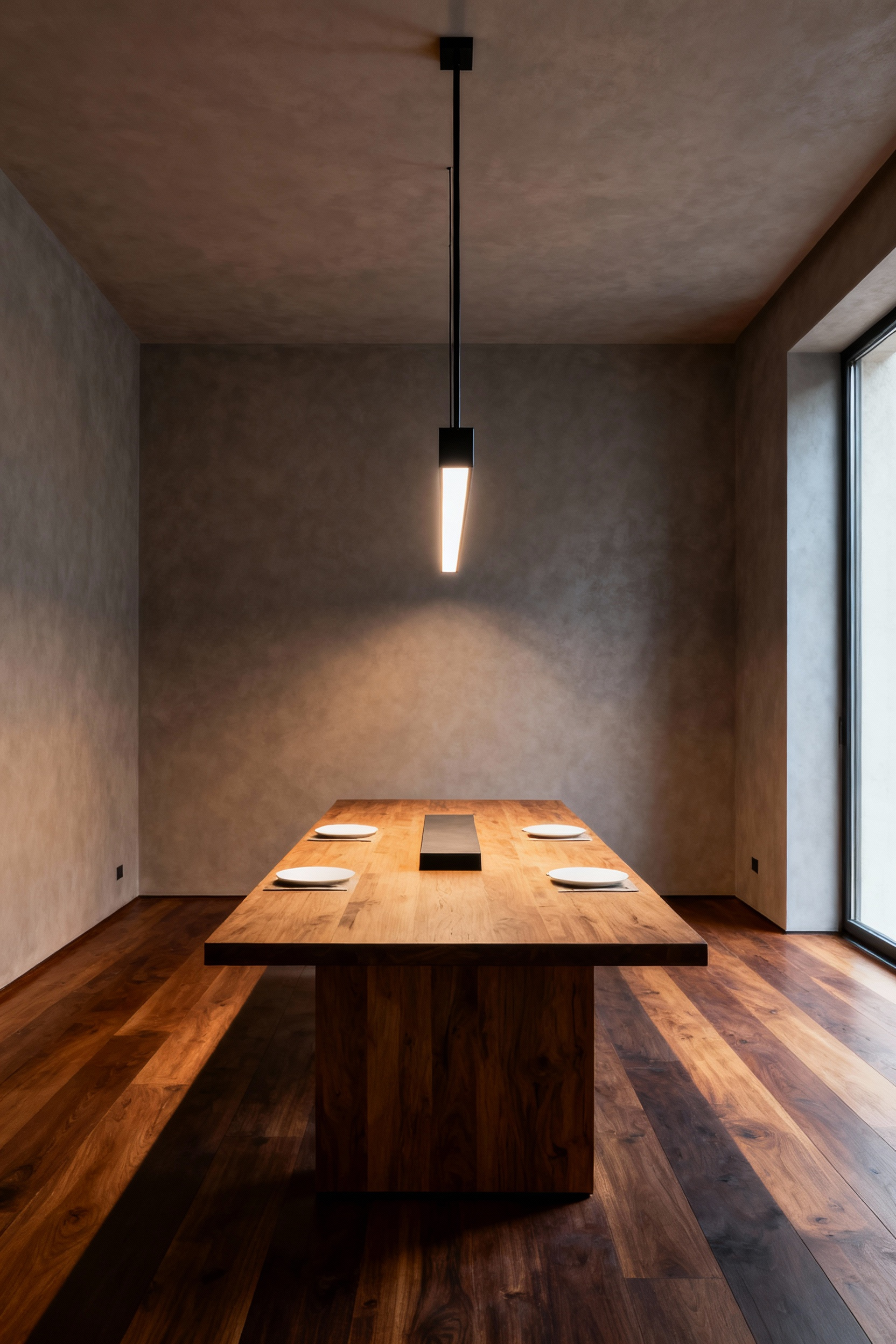
To achieve visual harmony, however, you must master the rules of proportion. Generally, a fixture should cover approximately two-thirds of the table’s length. This ratio distributes light evenly while leaving adequate clearance at the ends. Furthermore, hanging height is just as critical. Typically, suspend the fixture 30 to 36 inches above the tabletop. This specific placement illuminates the food without obstructing eye-level conversation.
Beyond measurements, the linear suspension actually shapes the room’s psychology. By casting a uniform pool of light, it focuses collective attention downward. Therefore, the distraction of dark corners disappears. This promotes shared connection. Additionally, selecting high-quality fixtures with frosted diffusers is essential. This avoids harsh hotspots. Also, prioritize units with high Color Rendering Index (CRI) capabilities. Ultimately, this ensures your culinary creations look vibrant.
2. The ‘Rule of Thirds’: Mastering Chandelier Proportion and Scale
Selecting the perfect chandelier requires balancing classical composition with functional needs. Primarily, this involves applying the specific “Rule of Thirds” to horizontal proportions. Specifically, your fixture’s diameter should measure between one-half and two-thirds of the table’s width. This ratio ensures the light anchors the space without overwhelming the furniture. Furthermore, strict adherence to this scale maintains a critical physical boundary. You must keep the fixture’s edges at least six inches inside the table’s perimeter. Consequently, this buffer prevents visual crowding.

Next, you must calibrate the vertical placement for human connection. Generally, the standard hanging height falls between 30 and 36 inches above the tabletop. This “sweet spot” is crucial for both ambiance and flow. Ideally, the light source sits just above eye level. Therefore, conversation flows freely across the table without obstruction. Additionally, this height concentrates a “pool of light” directly onto the food. If hung too high, that intimate energy disperses. Ultimately, proper scaling balances the table’s mass to create a harmonious focal point.
3. The Multi-Pendant Cluster: Creating a Modern, Deconstructed Centerpiece
The modern multi-pendant cluster represents a deliberate evolution from the traditional chandelier. Fundamentally, this fixture functions as a deconstructed sculpture suspended above your dining table. Instead of a single massive form, the cluster separates light into individual components. Specifically, the design relies on intentional asymmetry to create visual drama. By staggering drop lengths, you create a dynamic, three-dimensional “cloud” of light. Furthermore, the negative space prevents the arrangement from feeling heavy.
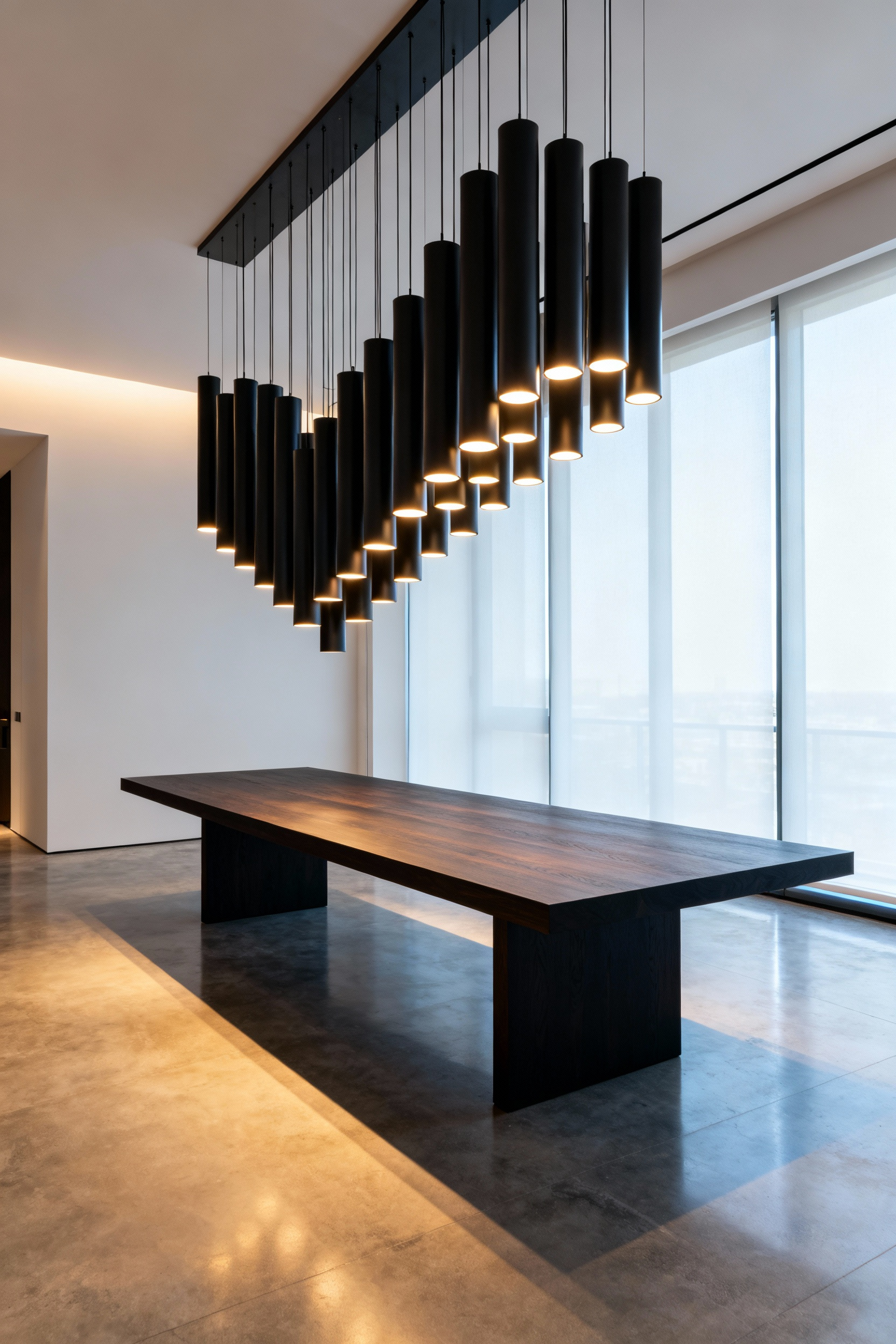
In open-concept homes, these clusters serve a crucial architectural role. Effectively, they define the dining zone without requiring walls. Thus, the fixture draws the eye upward, emphasizing ceiling height. Regarding materiality, options like hand-blown glass elevate the sensory experience. Distinctively, the exposed bulb often becomes the primary decorative element.
Consequently, the quality of light is softer and more evenly distributed. Unlike a single, intense beam, a cluster reduces harsh shadows on diners’ faces. Therefore, this setup is ideal for entertaining. It creates a cozy, intimate atmosphere. Ultimately, the multi-pendant cluster blends functional illumination with high-impact modern art. This contributes to an elevated dining room aesthetic.
4. The 30-Inch Standard: Perfecting Installation Height for Conversation
Ideally, dining room lighting sits 30 to 36 inches above the tabletop. Specifically, this standard anchors the space while facilitating social interaction. Ergonomically, this height perfectly clears the line of sight. Consequently, guests can maintain eye contact without peering around an obstruction. Furthermore, this specific positioning prevents the dreaded “glare bomb.” In fact, suspending the light just above eye level protects diners from blinding bulbs.

Beyond utility, this placement fosters a distinct sense of intimacy. Effectively, the lower height creates a concentrated, warm pool of light. Therefore, the dining zone feels comfortably separated from the rest of the room. Moreover, this close-range illumination casts a flattering glow on faces. It also enhances food presentation.
However, this rule is merely a starting point for standard eight-foot ceilings. For taller rooms, you must adjust the proportions linearly. Specifically, add three inches of hanging height for every additional foot of ceiling. Additionally, consider the fixture’s visual weight. Visually heavy chandeliers need more breathing room to avoid feeling oppressive. Conversely, airy fixtures can hang lower without blocking conversation. Ultimately, always test the height visually before final installation.
5. The Dimmable Difference: Transitioning from Morning Coffee to Evening Cocktails
Consequently, a well-designed dining space must adapt throughout the day. It shifts from a functional morning hub to an intimate evening sanctuary. Specifically, morning routines benefit from cooler, crisp light. Illumination between 4000K and 5000K mimics natural daylight. This stimulates alertness while you organize the day. This bright environment effectively supports task-oriented activities like reading the news.
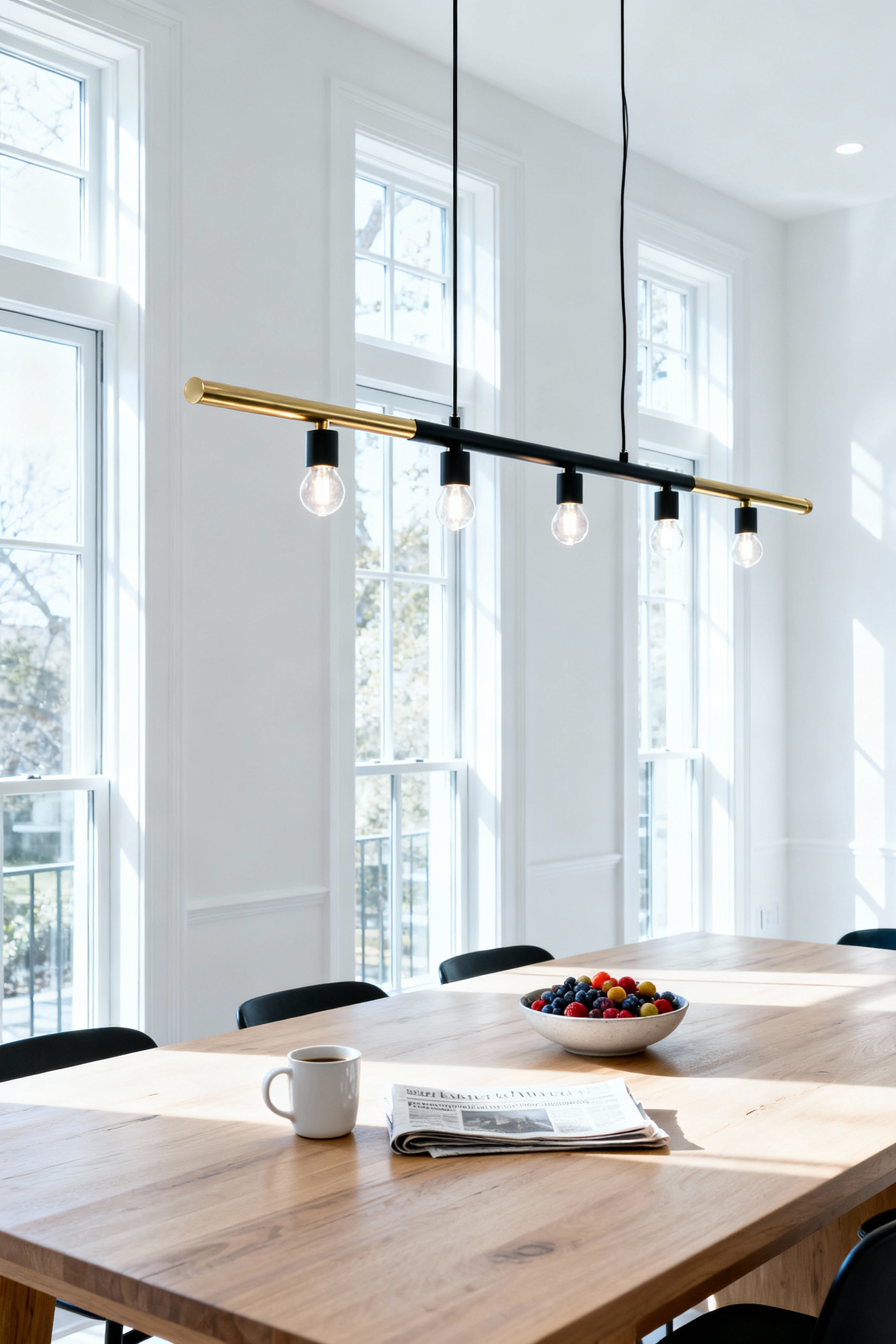
Conversely, evening cocktails demand a significantly softer approach. Warmer amber tones, typically around 2700K to 3000K, signal the brain to release melatonin. This fosters relaxation. Effectively, the chandelier transforms from a bright command center into a glowing “campfire.” It draws guests inward for storytelling. However, achieving this ambiance requires more than just lowering the brightness. Standard dimmers often produce a flat, grey cast.
Therefore, selecting fixtures with “Warm Dim” technology is crucial. As you lower the intensity, the color temperature automatically shifts warmer. It replicates the golden hue of candlelight at 1800K. Furthermore, this lighting quality directly impacts the sensory experience. High Color Rendering Index (CRI) ensures food remains vibrant. Ultimately, dimmable lighting acts as a mood orchestrator. It ensures your dining room serves efficiency and elegance seamlessly.
6. Kelvin Control: Why 2700K is the Sommelier of Color Temperatures
Just as a sommelier selects the perfect vintage, lighting temperature dictates the flavor of an evening. Specifically, 2700 Kelvin (K) serves as the gold standard for dining ambiance. This precise hue mimics the primitive comfort of candlelight. Consequently, it creates a subconscious signal that the workday has officially ended.
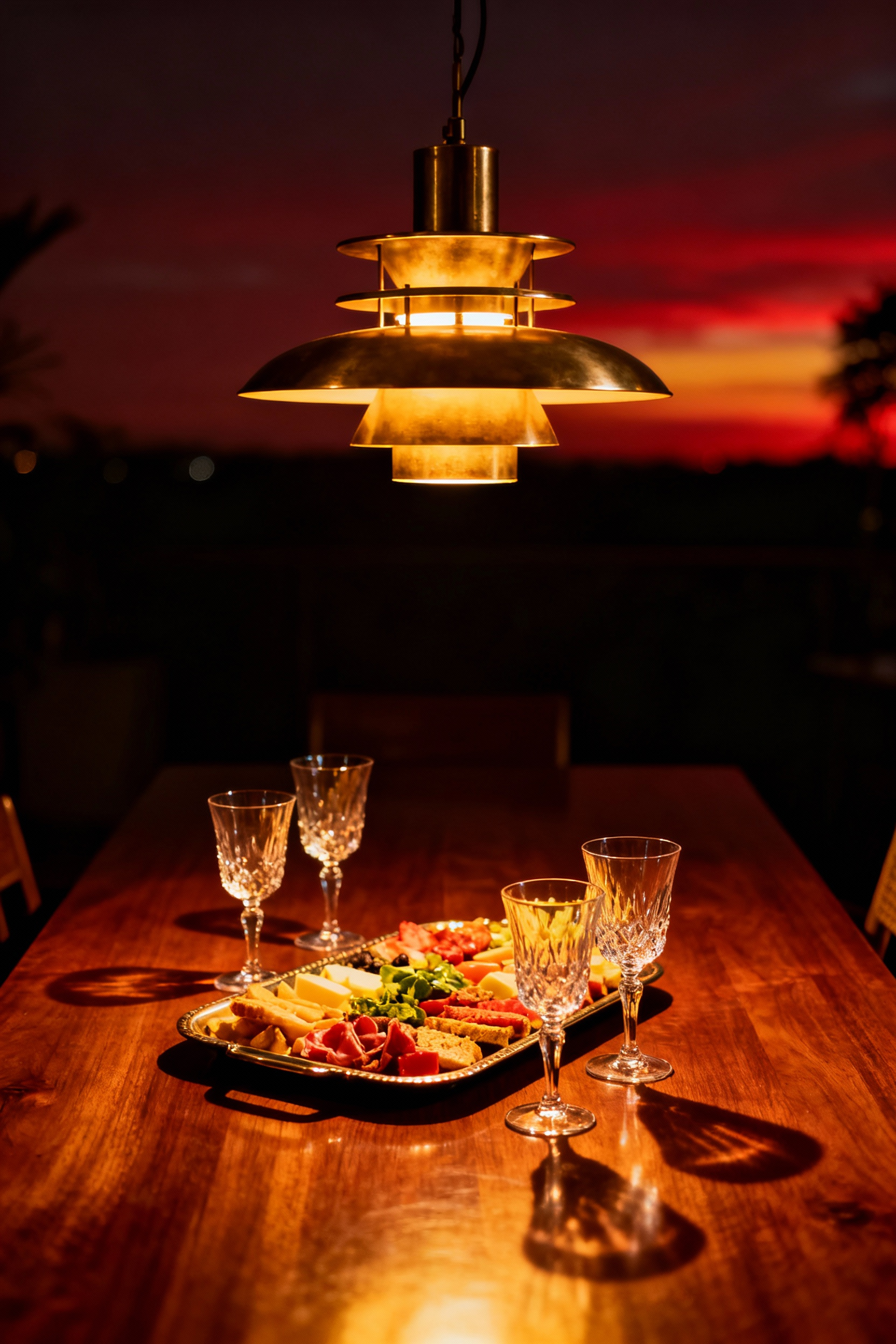
From a culinary perspective, this light acts as an appetizing filter. In fact, the warm, reddish-yellow bias deepens the rich colors of seared meats. Conversely, cooler lights often cast dull, blue tints on your dishes. Furthermore, 2700K is universally flattering for your guests. It gently softens complexions and minimizes imperfections. This fosters a more confident social environment.
While 3000K offers a crisper light suitable for kitchen prep, the dining table requires softness. Therefore, the priority here is the “linger factor.” Ultimately, this temperature emphasizes pleasure over visual clarity. It encourages guests to relax and savor the experience.
7. The Sculptural LED: When Your Light Fixture Doubles as Art
Modern dining rooms increasingly demand more than simple utility. Specifically, the “sculptural LED” trend elevates lighting fixtures into suspended contemporary art. Consequently, the chandelier becomes a stunning conversation starter. This aesthetic shift is powered by significant technological evolution. For instance, the miniaturization of cool-running LED chips creates new design possibilities. Designers are finally freed from bulky traditional bulbs. Therefore, light can be embedded directly into slim metal profiles.
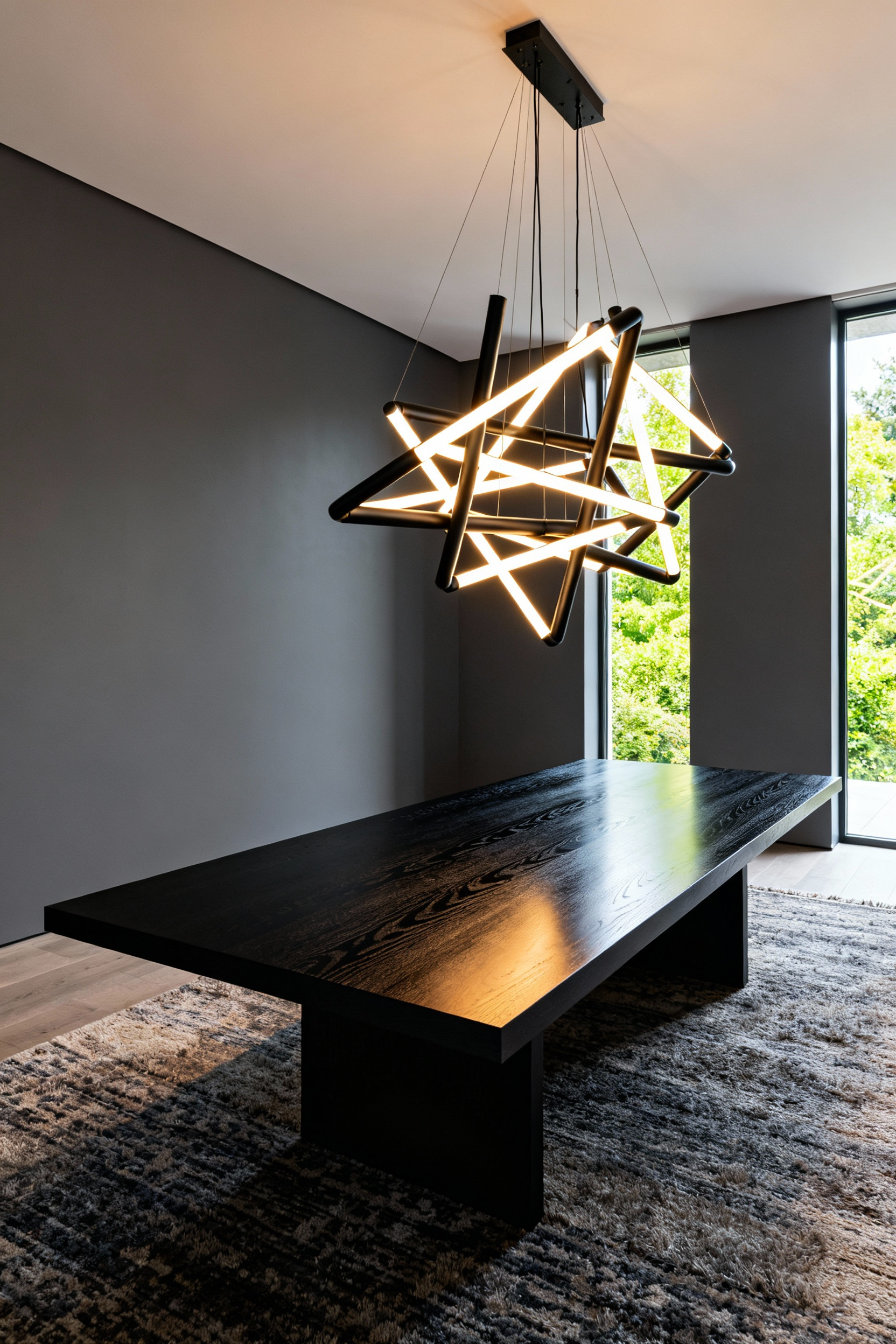
Functionally, these freeform shapes do more than look beautiful. In open-concept spaces, large architectural fixtures visually anchor the dining table. Notably, they define the gathering zone without requiring walls. Furthermore, the quality of light is engineered for intimacy. Instead of harsh beams, these sculptures often produce a layered, indirect glow. This creates a soft atmosphere where guests look exceptional. Additionally, the complex structures cast dynamic shadows on the ceiling. Thus, the fixture acts as a kinetic art piece.
8. Softened Glow: Fabric Drum Shades for Glare-Free Intimacy
Fabric drum shades offer a sophisticated solution for common lighting challenges. Primarily, their architectural design works to eliminate harsh glare. Specifically, the inclusion of a bottom-side diffuser is the critical component. This opaque disc shields diners’ eyes from the bare bulb’s high intensity. Therefore, disability glare is neutralized. This ensures visual comfort even when the fixture hangs at eye level.

Beyond simple mechanics, these shades create a distinct psychological atmosphere. For instance, the soft, diffused light encourages guests to relax. In fact, this lighting creates a “soft focus” effect that flatters faces. This promotes comfortable eye contact. Furthermore, the cylindrical shape balances illumination perfectly. It directs a gentle wash of ambient light upward while focusing task lighting downward.
From a culinary perspective, this specific quality of light is essential for presentation. Ideally, you should pair these shades with a warm white bulb between 2700K and 3000K. Consequently, rich colors in food, like deep reds, appear vibrant. Additionally, the fabric choice subtly alters the mood. Linen provides a natural, timeless glow. Silk adds a layer of formal richness. Ultimately, this fixture style ensures the meal remains the visual center.
9. Visual Weight: Balancing Heavy Metals with Airy Open-Concept Spaces
In expansive, open-concept homes, dining areas often lack definition. Consequently, the space can feel temporary. To combat this, designers utilize the “visual weight” of heavy metals. This creates a focal point. Specifically, materials like wrought iron and dark-finish bronze provide necessary gravitas. Historically, these durable metals symbolized permanence. Today, they act as a visual anchor. They effectively ground the dining table within a vast room.
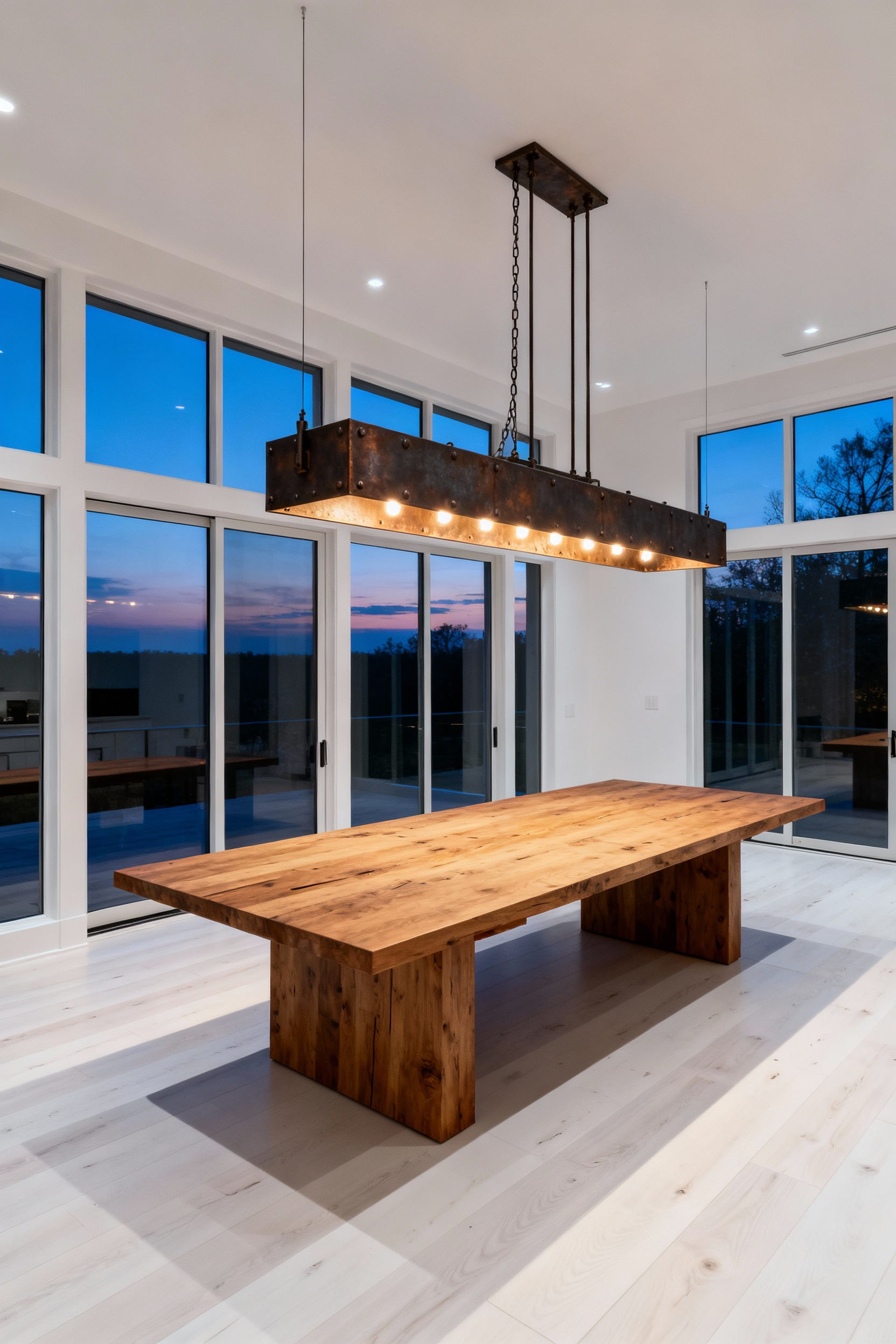
However, inserting a heavy object requires careful balance. Therefore, the design must leverage negative space. You should look for fixtures featuring open-cage or linear frame designs. In fact, this structure allows sightlines to pass directly through the metalwork. Thus, the fixture defines the space without cluttering the floor plan.
Furthermore, the choice of finish dramatically alters this visual tension. For instance, matte-black absorbs light, feeling structural and solid. Conversely, polished nickel reflects natural daylight. This makes the metal appear lighter. Additionally, incorporating clear glass creates a soft material dialogue. Ultimately, the heavy fixture functions as a sculptural “punctuation mark.” It establishes an intimate zone for entertainment.
10. Layering the Room: Supporting Actors (Sconces and Buffet Lamps)
While the central chandelier acts as the lead, sconces and buffet lamps are essential supporting actors. Effectively, they establish subtle, horizontal planes of light. This completes the room’s visual story. Specifically, wall sconces provide critical architectural depth. They anchor the room’s perimeter. Positioned typically between 60 and 72 inches from the floor, they illuminate guests’ faces from the side. Therefore, harsh overhead shadows soften. This creates a universally flattering glow.
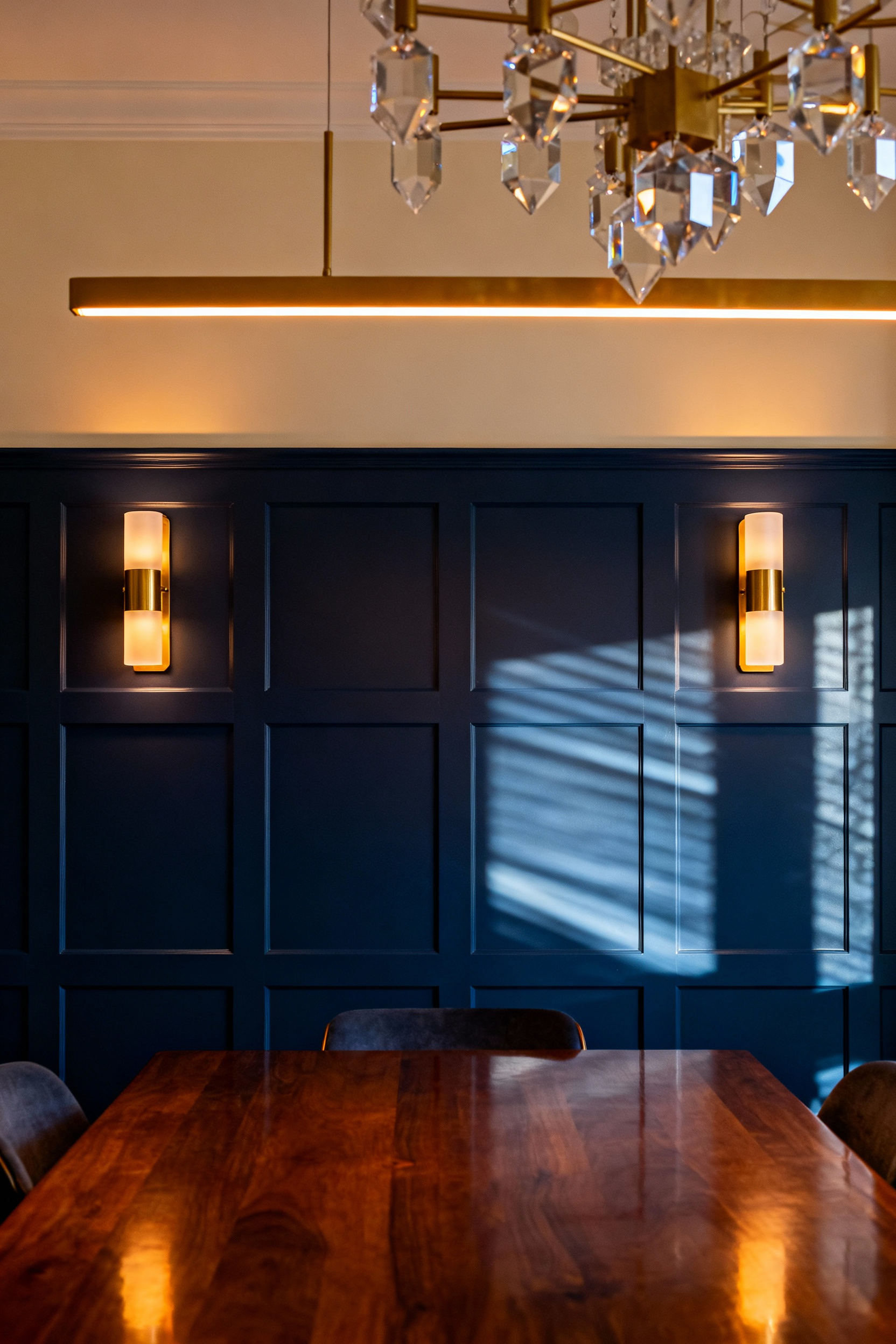
Additionally, these fixtures serve a decorative purpose. Often, designers use them in pairs to flank a mirror. This establishes a formal symmetry. Conversely, buffet lamps focus intensely on functionality. Designed with tall, slender profiles, they preserve precious surface space. Consequently, they highlight the food display without overcrowding the sideboard.
Ultimately, the goal of this layer is creating “Light for Feeling.” To achieve this intimacy, select bulbs in the 2700K to 3000K range. This temperature mimics the psychological warmth of sunset. Furthermore, ensure a Color Rendering Index (CRI) of at least 90. High CRI ensures your culinary creations look vibrant. Thus, accurate lighting invites guests to relax.
11. The Oversized Statement: Breaking Rules with Bold Proportions
For decades, lighting design relied on a strict mathematical formula. Specifically, conventions dictated that fixtures measure only half the dining table’s width. However, modern aesthetics are deliberately abandoning this conservative ratio. Today, the “oversized statement” prioritizes emotional impact. It values drama over safe calculations.
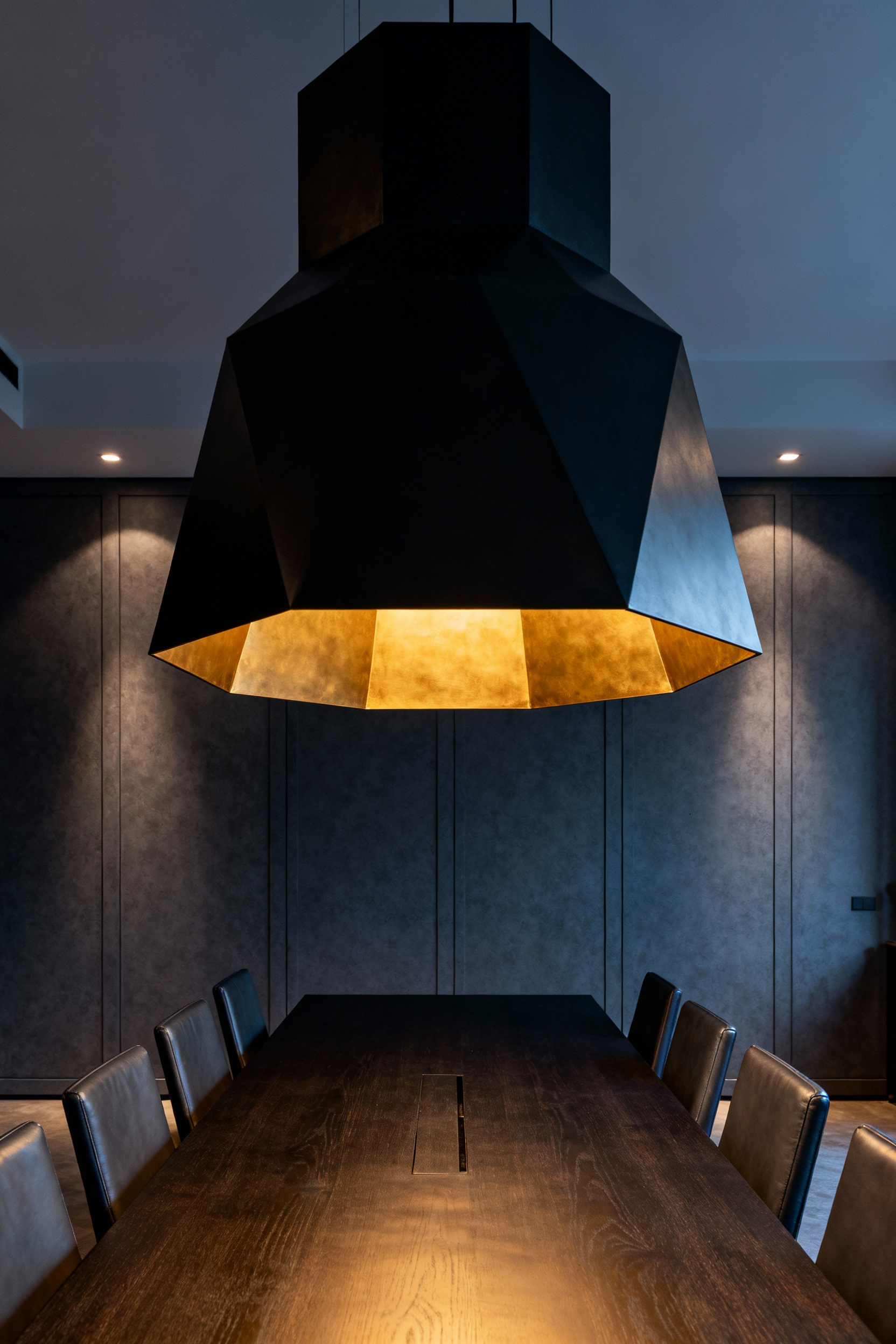
Consequently, the new guideline for scale is purely functional. You must simply ensure the fixture does not extend within six inches of the table’s edge. This crucial buffer prevents guests from bumping their heads. Therefore, you can maximize drama without impeding the workflow.
Beyond mere spectacle, these massive proportions serve a psychological purpose. In open floor plans, a giant fixture acts as a heavy visual anchor. It grounds floating furniture. This effectively defines the dining zone. Furthermore, hanging these large pieces low creates a distinct “cocoon” effect. This visual canopy compresses the vertical space. It fosters a sense of protected intimacy among diners.
Finally, the style of these statements has evolved. We are moving away from heavy crystal chandeliers. Instead, the focus is on texture and architectural form. For instance, massive linen drum shades offer warmth rather than glitz. Ultimately, an oversized fixture transforms into a central piece of art.
12. Mixed Materiality: Pairing Brass and Matte Black for Sophisticated Contrast
Combining brass with matte black is more than just a passing trend. Specifically, this pairing creates a sophisticated balance between warmth and visual weight. The appeal lies in the fundamental opposition of these two distinct finishes.
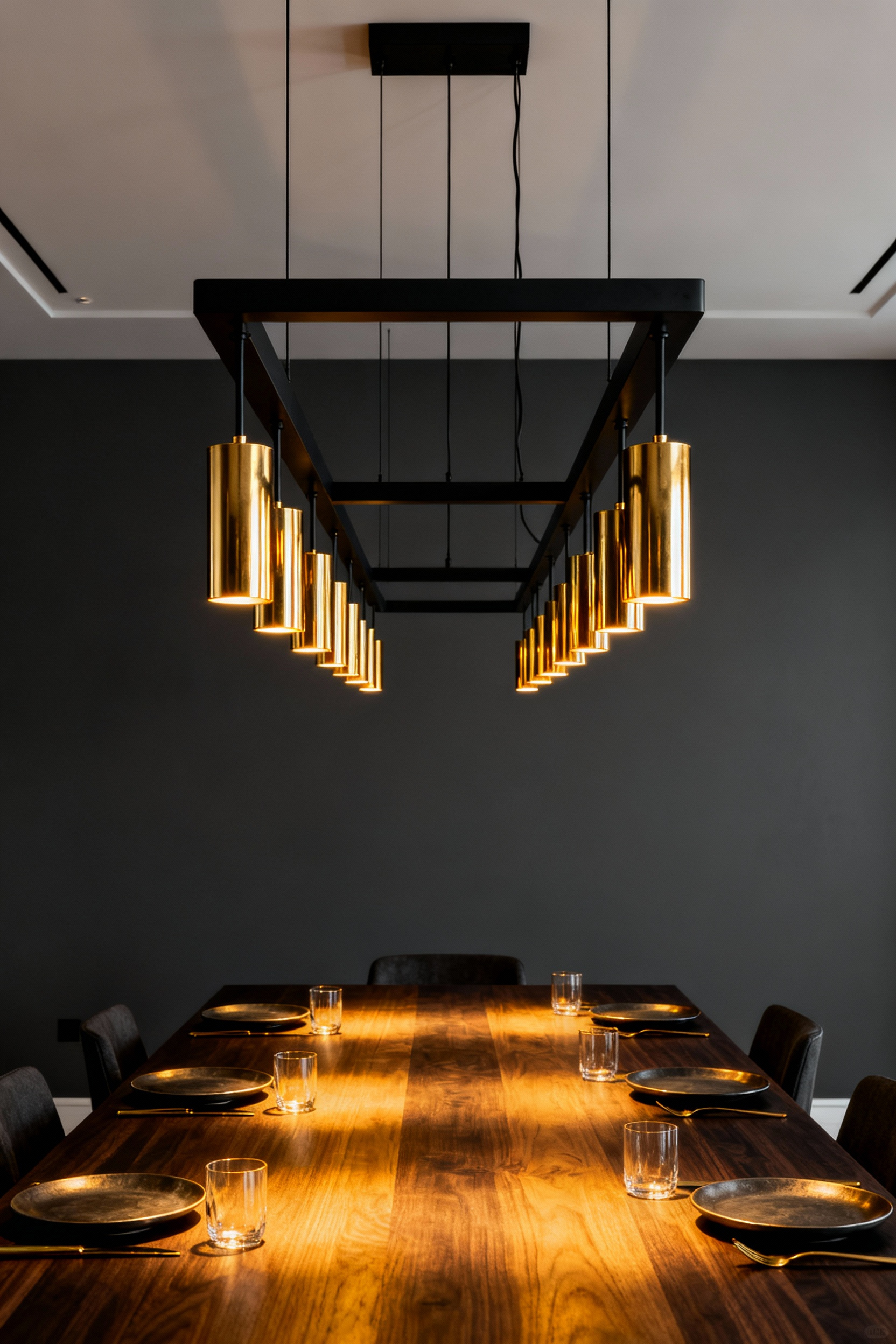
Brass is inherently warm and acts as a natural light reflector. Consequently, it scatters a soft, golden glow across the dining table. This illumination is crucial for entertaining. It flatters both complexions and the culinary presentation. Conversely, matte black serves as a neutral, absorptive anchor. It grounds the design against the ceiling. Therefore, the fixture provides structural definition without causing distracting glare.
Moreover, this mixed materiality perfectly embodies the Transitional design movement. Satin brass honors historical elegance without being flashy. In contrast, the matte black finish introduces a sleek, modern edge. This duality allows the fixture to bridge the gap between traditional and contemporary styles.
Practically, the matte texture offers significant functional benefits. For instance, powder-coated black finishes are highly resistant to fingerprints. Thus, maintenance remains low even in high-traffic zones. Ultimately, this combination ensures the dining room feels luxurious yet grounded.
13. Organic Textures: Woven Rattan and Wood for Relaxed Gathering
Lighting choice extends beyond pure utility. It influences the entire mood of a meal. Specifically, incorporating woven rattan and natural wood shifts a fixture’s role toward experience design. These materials embody Wabi-Sabi principles by celebrating timeless craftsmanship. Consequently, they introduce a tranquil, grounded aesthetic to your dining space.
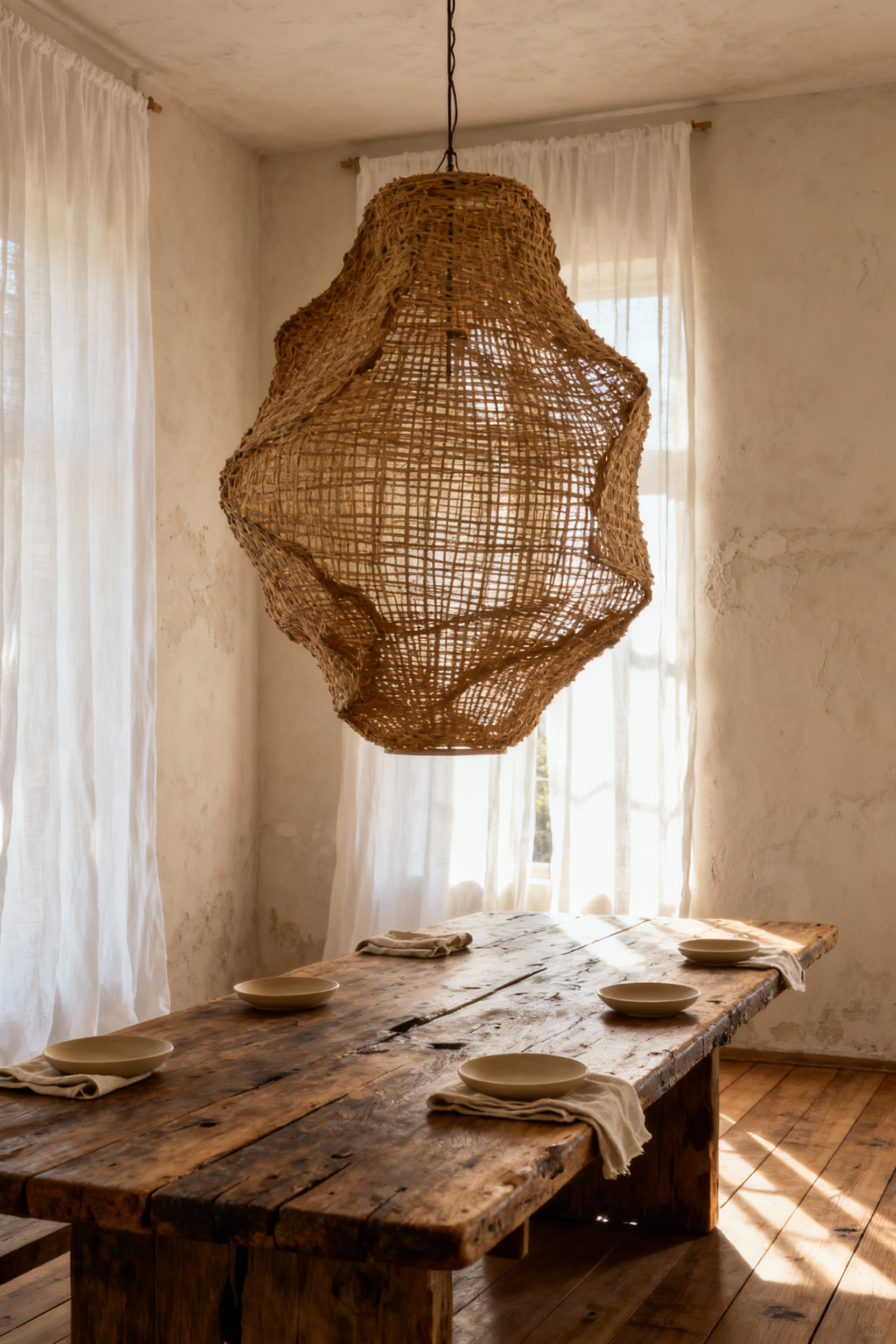
Functionally, woven shades act as effective natural diffusers. Instead of casting harsh glare, the open mesh softens the light source. As a result, the weave creates a soft “geometric dappling” effect on surrounding walls. This low-contrast shadow play fosters intimacy. It subtly encourages guests to linger longer over meals.
Similarly, solid wood elements enhance this warm glow. To maximize this effect, designers often recommend bulbs with low color temperatures. Aim for 1,900 to 2,300 Kelvins. This golden hue complements natural timber tones perfectly. Furthermore, shallow-angle lighting can highlight the wood’s grain texture.
Ultimately, these fixtures satisfy biophilic design goals by bringing the outdoors in. Whether in a Coastal or Modern Minimalist home, organic textures provide contrast. They transform a dining room from a sterile eating area into a space for relaxed gathering.
14. The New Crystal: Reinventing Formal Sparkle for Contemporary Homes
The days of heavy, tiered chandeliers dominating the dining room are largely behind us. Instead, “The New Crystal” emphasizes minimalist geometry over ornate opulence. Specifically, these modern fixtures treat lighting as architectural art. For instance, designers now favor linear or rectangular forms. This mirrors the dining table below, creating a clean, horizontal line.
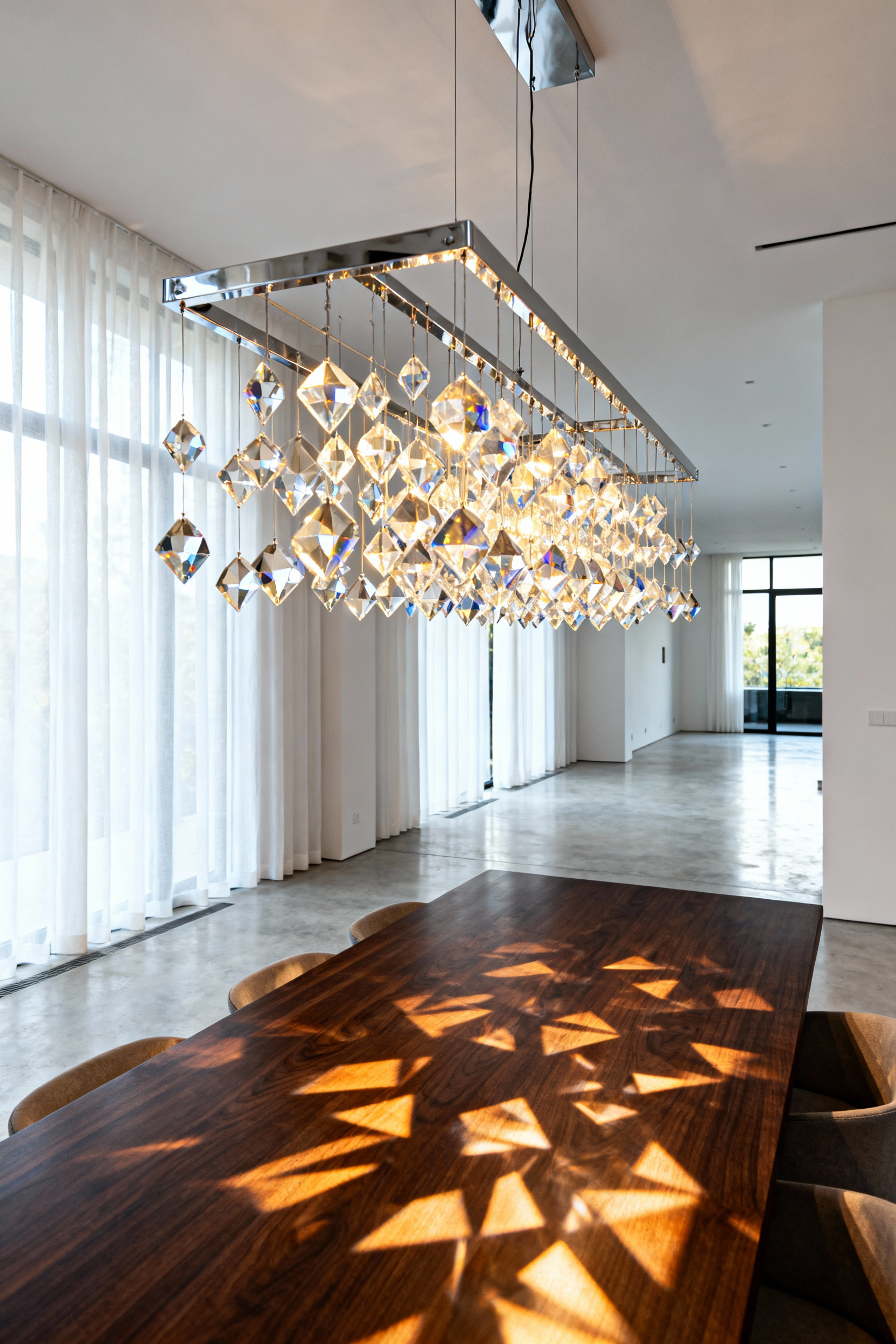
Moreover, the materials themselves have evolved significantly. Contemporary designs frequently utilize K9 crystal, known for its high refractive index. Consequently, the sparkle is sharper and more precise than older leaded glass. Furthermore, this visual clarity is enhanced by integrated LED technology. Unlike bulky incandescent bulbs, small LEDs allow for “floating” light points embedded directly within the crystal structure.
Therefore, you gain total control over the dining atmosphere. With dimmable capabilities, these fixtures shift easily from bright workspace to intimate glow. In fact, this versatility transforms the fixture into “functional jewelry.” It adds a sophisticated layer of texture without visual clutter. Ultimately, the new crystal offers controlled glamour.
15. Smart Integration: Voice-Controlled Ambiance for Hands-Free Hosting
In the heat of hosting, managing the atmosphere should never require leaving the conversation. Consequently, voice control acts as a vital, invisible assistant. It allows you to maintain total composure while adjusting the environment. Advanced platforms like Josh.ai utilize Natural Language Processing for conversational nuance. Therefore, you avoid robotic syntax entirely. Simply say, “Warm the dining room lights.” The system understands the context immediately.
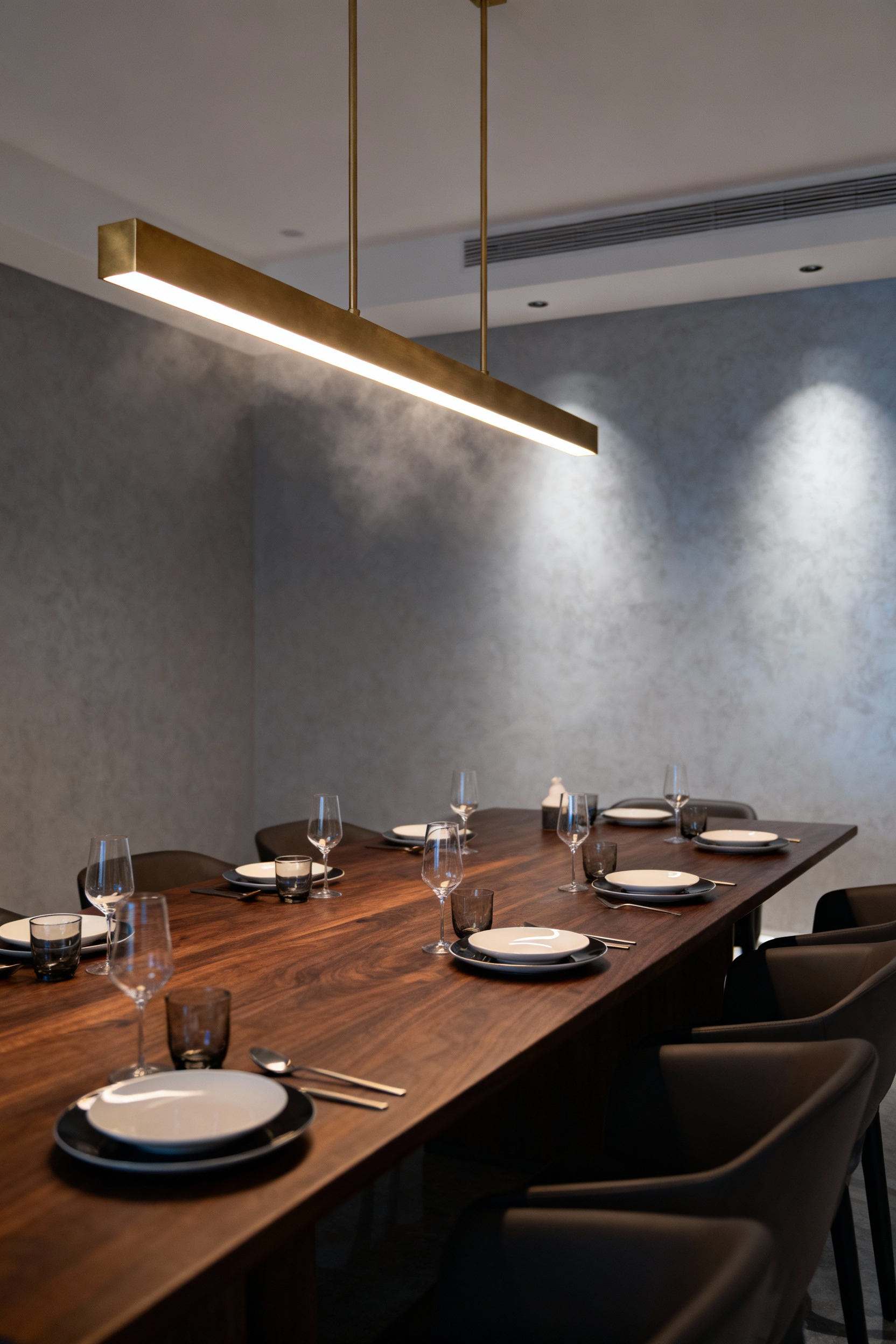
Furthermore, this integration directly enhances the culinary presentation. High-end fixtures often feature Tunable White technology. Initially, you might request a crisp 3000K setting for plating food. This ensures high Color Rendering Index (CRI) visibility. As a result, wines appear deep red and roasts look vibrant. Later, a command like “Set Dessert Scene” shifts the temperature to 1800K. This instantly mimics the flattering warmth of candlelight.
Finally, true functionality relies on system-wide orchestration. “Hands-free hosting” implies a cohesive environment change. Specifically, one phrase can dim the chandelier and lower motorized shades simultaneously. Thanks to the emerging Matter protocol, these connections are incredibly reliable. You essentially eliminate technical lag. Ultimately, voice control transforms complex mechanics into effortless hospitality.
16. Ceiling Medallions: The Architectural Jewelry Often Forgotten
Historically, ceiling medallions served a purely utilitarian purpose. Specifically, these plaster elements acted as essential barriers against soot. Today, however, they function as “architectural jewelry.” They transform a standard light fixture into a deliberate focal point. Consequently, choosing the correct size is a matter of precise proportion.
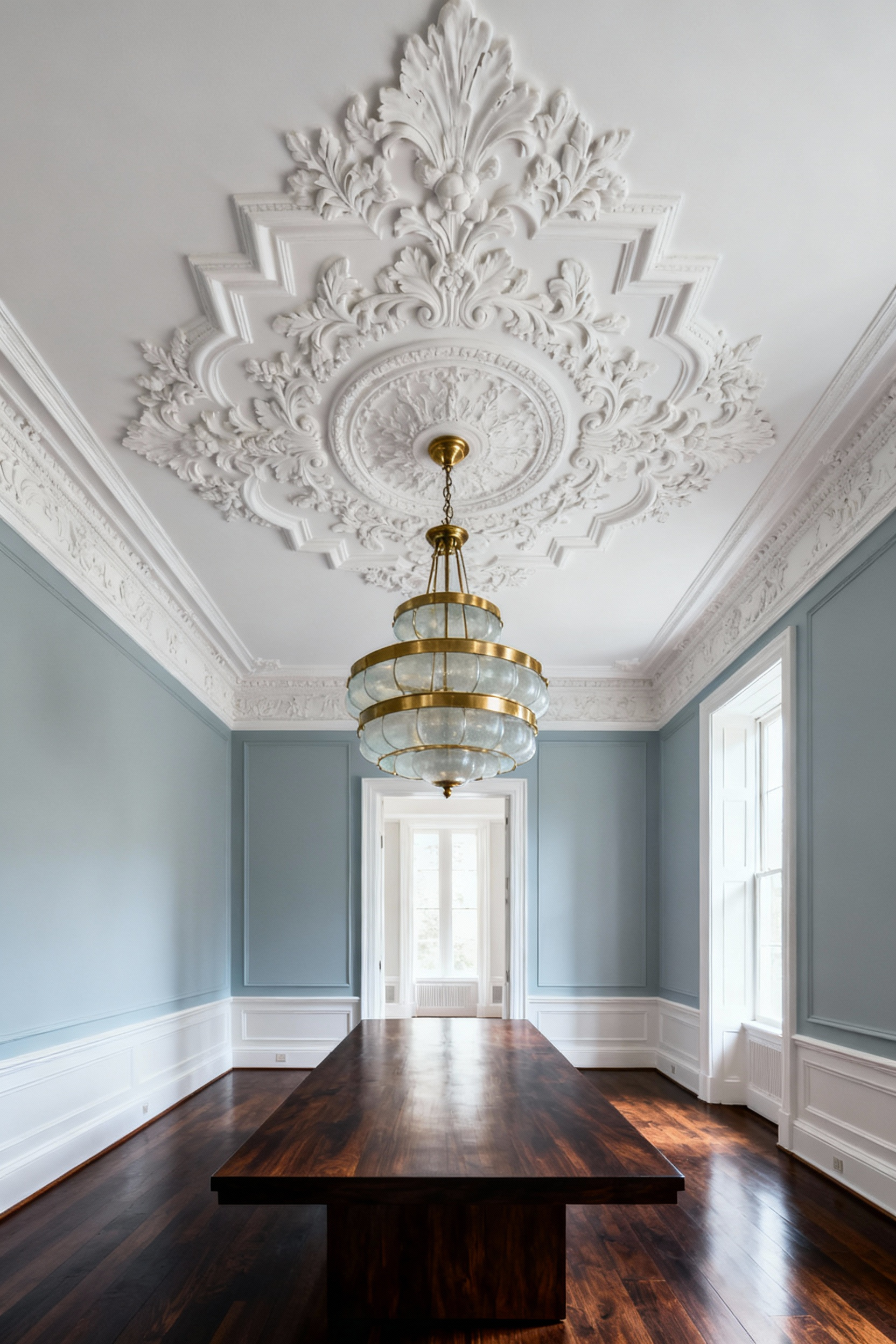
To find the ideal diameter, multiply the room’s length by its width. Then, divide the result by seven. Furthermore, you must ensure the medallion is wider than the light fixture itself. If both elements share the same diameter, they create an awkward “virtual column.” This visually compresses the space. Additionally, higher ceilings often demand scaled-up proportions to prevent the design from looking lost.
Beyond dimensions, the finish dictates the atmosphere. For instance, designers often use glazing techniques to highlight intricate details. By wiping a dark glaze over a base color, shadows settle into the crevices. Alternatively, metallic leaf offers a functional benefit. In fact, gilded surfaces act as subtle reflectors. They diffuse a warm, inviting glow across the ceiling. Ultimately, whether utilizing classic scrolls or modern forms, this detail anchors the dining experience.
Designing for the Memories Created Beneath the Glow
Ultimately, dining room light fixtures serve as more than a simple source of illumination. In fact, they act as an atmospheric engineer. They dictate the emotional rhythm of your meals. By choosing warm temperatures, you subconsciously encourage guests to linger. Furthermore, high-CRI bulbs ensure your culinary efforts look as vibrant as they taste. Consequently, the fixture transforms from a static object into a functional tool for connection. It creates a dedicated “light well” that centers attention on shared moments.
Therefore, consider your lighting choices as an investment in future memories. The right glow turns an ordinary dinner into a restorative ritual. As a result, your dining room becomes a sanctuary for meaningful interaction. However, this atmosphere requires intentional planning. Begin by auditing your current bulbs for warmth today. Finally, let the light guide your guests toward comfort.
Frequently Asked Questions (FAQ) About Dining Room Light Fixtures
How should I size my dining room light fixture relative to the table?
For chandeliers and linear fixtures, the standard rule of proportion dictates that the fixture’s diameter or width should measure between one-half and two-thirds of the table’s width. Additionally, the edges of the fixture must hang at least six inches inward from the perimeter of the table to prevent visual crowding and head bumping.
What is the best Kelvin (K) color temperature for dining room light fixtures?
The ideal color temperature is 2700 Kelvin (K). This warm, golden hue mimics candlelight and incandescent bulbs, creating a flattering, intimate atmosphere perfect for relaxation and lingering. While 3000K is suitable for task lighting, 2700K provides superior ambiance and makes food look richer and more appetizing.
How high above the dining table should a fixture be installed?
The standard hanging height for a dining room light fixture is 30 to 36 inches above the tabletop. This placement ensures the light clears the line of sight for seated diners, preventing glare while concentrating the illumination directly onto the food and faces for an intimate glow. Adjust this height higher for ceilings taller than eight feet.
